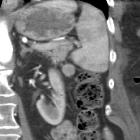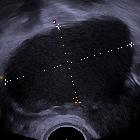splenosis
























 nicht verwechseln mit: Nebenmilz als Normvariante
nicht verwechseln mit: Nebenmilz als NormvarianteSplenosis is one type of ectopic splenic tissue (the other being accessory spleen). It is an acquired condition and is defined as autoimplantation of one or more focal deposits of splenic tissue in various compartments of the body.
Abdominal splenosis is seen after abdominal trauma or surgery (e.g. splenectomy). They result from seeding of the peritoneal cavity with splenic tissue which recruits local blood supply. They are typically small, sessile (as they grow on serosal/peritoneal surfaces) and multiple. They may grow over time to become quite sizable. If located only intrahepatically, they can cause serious diagnostic problems.
A similar process occurring in the thorax is called thoracic splenosis. It is rare and presents as multiple pleurally-based nodules in the left hemithorax. It typically occurs following blunt trauma causing a combination of splenic injury and left diaphragmatic rupture .
They are benign*, their greatest importance being the need to distinguish them from more sinister pathology.
*they are benign, but any pathology that can develop in the normal spleen can also arise within the splenic tissue foci
Radiographic features
CT
They are typically rounded or sessile nodules, and have density and enhancing characteristics similar to the rest of the spleen, or expected density of the spleen if there has been a splenectomy.
MRI
Signal characteristics are similar to normal spleen
- T1: hypointense
- T2: hyperintense
- T1 C+ (Gd): heterogeneous enhancement
Nuclear medicine
Tc-99m sulfur colloid scan
The diagnosis can be confirmed with Tc-99m sulfur colloid scan which will demonstrate increased uptake as long as the splenunculus is at least 2 cm in diameter; improved sensitivity with hybrid imaging (SPECT-CT) is possible .
When Tc-99m sulfur colloid fails to confirm the presence of splenic tissue, Tc-99m-tagged heat-damaged RBC scan (Tc-99m-DRBC) with autologous erythrocytes remains the gold-standard of imaging, being capable of specifically proving splenic tissue .
Differential diagnosis
Splenosis should not be confused with polysplenia or accessory spleens (splenunculi), which are congenital in origin and retain arterial supply from the splenic artery. They are also composed of normal splenic tissue. Depending on their location they may appear to be arising from various organs, and thus mimic malignancy.
The differential diagnosis for soft tissue nodules includes
- peritoneal metastases
- enlarged lymph nodes (abdominal lymphadenopathy)
- endometriosis
Siehe auch:
und weiter:

 Assoziationen und Differentialdiagnosen zu Splenose:
Assoziationen und Differentialdiagnosen zu Splenose:





